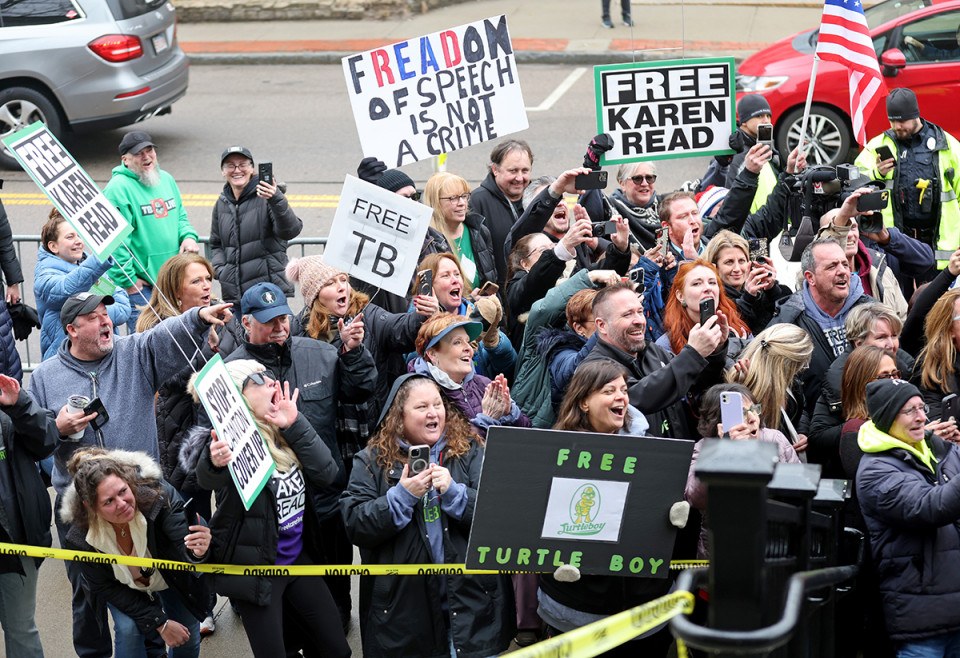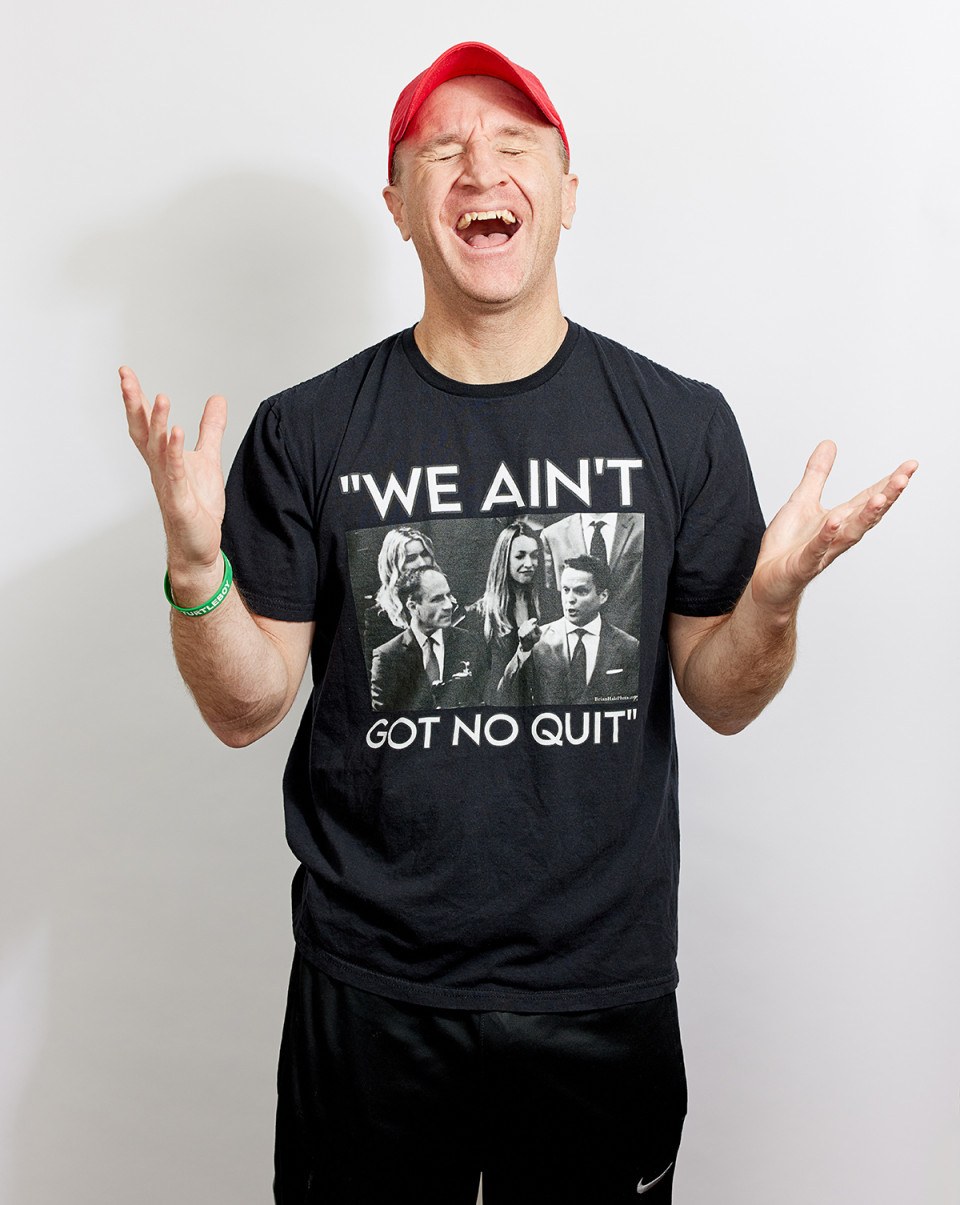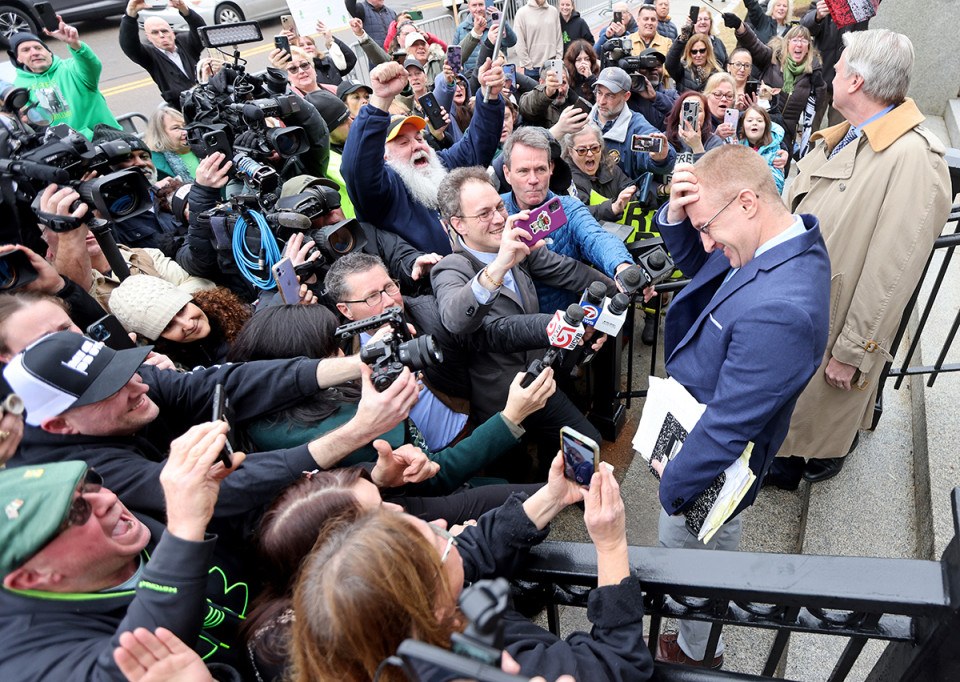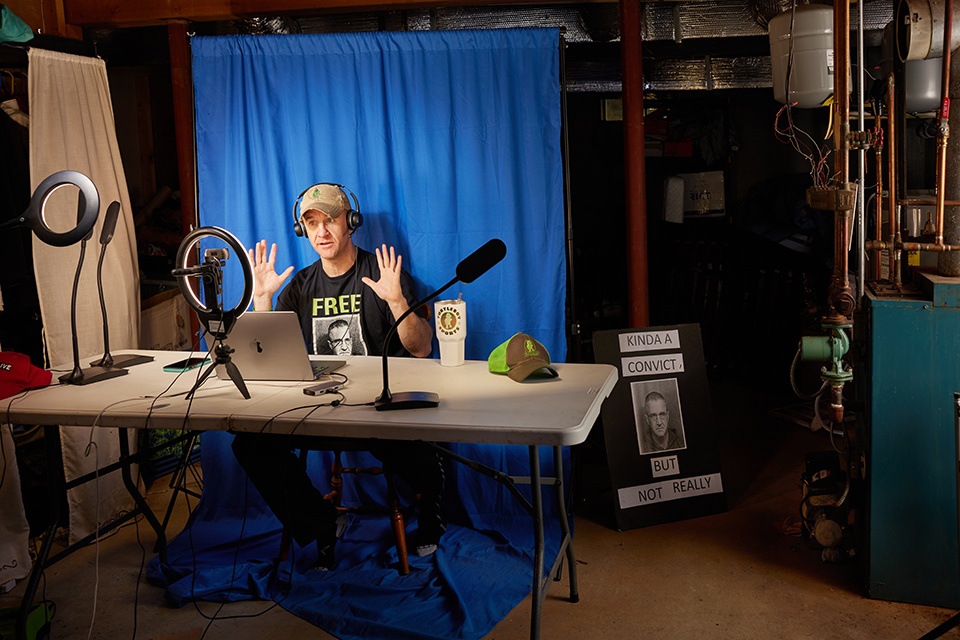“Free Karen Read” Blogger Turtleboy Will Not Go Quietly
Controversial Massachusetts blogger Aidan Kearney says he’s a confrontational truth teller intent on righting wrongs. Critics, though, say he’s a mean-spirited bully. Maybe he's both?

Portrait by Ken Richardson
From behind the thick glass partition, Aidan Kearney was almost unrecognizable. Usually, as his online alter-ego Turtleboy, the central Massachusetts blogger and livestreamer is seen sitting in a comfy office chair, wearing a self-branded baseball hat and T-shirt from his website’s merch store, and addressing a YouTube audience of thousands through a headset. Today, on a Tuesday evening in February, Kearney sat on an uncomfortable stool, bare-headed, wearing a state-issued orange jumpsuit, the only screen before him the glass divider. Through an old-fashioned phone receiver, he spoke in a subdued tone to an audience of exactly one.
I was visiting Kearney at Dedham’s Norfolk County Correctional Center on day 50 of what would be his 60-day incarceration. The 42-year-old landed here in December after a woman with whom he’d had an extramarital affair accused him of assault. Kearney told me the charge was a ploy that law enforcement officials cooked up with his jilted lover. “They are just trying to silence me,” he insisted. (Less than two weeks later, the assault and battery charge for allegedly shoving and threatening the woman would be dismissed.)
Credible charges or temporary muzzle, there is little doubt that law enforcement and the Norfolk County District Attorney’s Office would like nothing more than for Aidan “Turtleboy” Kearney to just shut up. Until he started covering the 2022 Canton death of Boston Police Officer John O’Keefe, the Norfolk County DA’s murder charges against O’Keefe’s girlfriend, a Mansfield equity analyst named Karen Read, had received scant media attention. Then, in April 2023, Kearney started focusing on the case, posting multiple stories a day on his TB Daily News site; livestreaming two, sometimes three times a week on YouTube; and claiming that law enforcement officers and witnesses were framing Read in an elaborate conspiracy to protect O’Keefe’s true killers. Almost single-handedly, through relentless blogging and YouTube streaming, Kearney upturned public perception of what seemed like an open-and-shut case, casting a thick cloud of doubt on the workings of our justice and law enforcement systems. (At presstime, Kearney’s first post about the case—“Canton Cover-Up Part 1: Corrupt State Trooper Helps Boston Cop Coverup Murder of Fellow Officer, Frame Innocent Girlfriend”—had accumulated more than 460,000 page views.)
But Kearney didn’t just amplify the Read case; he also mobilized thousands of people to feel personally invested in its outcome. Over the past year, Kearney’s followers have joined him outside pretrial court hearings, “Free Karen Read” banners in hand, and showed up at the homes and businesses of witnesses who, Kearney alleges, are responsible for O’Keefe’s death and the subsequent cover-up. They’ve raised more than $300,000 for Read’s legal defense and funded a “Free Karen Read” Route 1 billboard outside of Gillette Stadium with a QR code to fundraise even more. Thanks to Kearney’s involvement, the Read case has drawn the attention of national media, Hollywood producers, and true-crime hobbyists across the country and has become a grassroots movement the likes of which the state seldom sees.
The case has been a life-changing event for Kearney. His near-obsessive focus on the crime doubled his page views, earned him hundreds of thousands of dollars, fostered a cult-like fan following of “Turtle Riders” who’ve taken to calling him “Journalism Jesus,” and made him a public figure women can’t seem to resist. (By Kearney’s own estimation, he’s the beneficiary of an average of two sex propositions a week.)

Aidan “Turtleboy” Kearney was arrested on witness intimidation charges in connection with the Read murder case. He insists it’s a ploy to silence him. / Photo by Matthew J. Lee/the Boston Globe via Getty Images
For someone who has always reveled in being the class clown, all of that attention has been electrifying. Until, that is, he got burned. First, in October, Kearney was charged with eight counts of witness intimidation, four charges of picketing a witness, and one charge of conspiracy to commit witness intimidation (additional picketing and conspiracy charges would be heaped on in December). The charges stem from what he wrote on his blog and said on YouTube, as well as from his “Free Karen Read” rallies and aggressive livestreaming interview tactics with people involved in the case, including approaching a witness at her daughter’s lacrosse game and calling her a “cop killer.” For those charges, he was released on bail.
Then came the trouble with the girlfriend, Lindsey Gaetani, which was also a byproduct of his blogging. They met when she sent him a sexy picture of herself in a “Free Karen Read” T-shirt purchased from his website’s merch store. In the messages that followed, she called him a “superhero” with “balls of steel.” They became involved, and after Kearney tried to break up with her, he claims, she became a state witness against him, accusing him of assaulting her on Christmas Eve and earning him the assault and battery charge, which was later dropped, plus yet another witness intimidation charge. His prior bail was revoked, and he was jailed on his 42nd birthday.
Kearney, by his own admission, had now hit rock bottom. During my visit, he told me he was devastated at being separated from his two children, an nine-year-old daughter, Allison, and a six-year-old son, Brady. (Yes, named after Tom.) Locked up, he was suffering from depression, unable to take the Adderall he’s been prescribed for 20 years—because it has a street value, it’s not allowed in jail—and wasn’t sleeping well. He had no Internet access, which for Kearney is akin to denying him oxygen. He told me he never struck his ex-girlfriend, and claimed she was mentally unstable, a serial violence-prevention-order seeker, and a liar who was mad that he broke up with her. If he was guilty of anything, he said, it was of having bad taste in women. Conversely, Gaetani says she is the one with bad taste in men—as evidenced by her need to seek restraining orders against multiple people—and that Kearney had used threats of suicide to manipulate her when she tried to break up with him because she found him to be mentally unstable and a liar. This is not the only relationship in Kearney’s life that has a dueling-narrative dynamic to it. “My personal life was in chaos,” Kearney said that day, shaking his head. “But I’m not a criminal.”

Turtleboy supporters in Dedham in February 2024. / Photo by Matt Stone/MediaNews Group/Boston Herald via Getty Images
His incarceration outraged his fans, who have rallied around his claims that he is a “political prisoner,” and elated critics, who believed he was long overdue for a reckoning. After all, before the Read case, Kearney had already been a controversial figure. For more than a decade, Kearney—on Turtleboy Sports and later TB Daily News—has published blunt, caustic, and opinionated takes on micro-regional controversies. He built the Turtleboy brand on ridiculing “ratchets,” Kearney’s preferred shorthand for trashy Massholes behaving badly. (Think pregnant women smoking.) He has a fondness for calling public figures things like “dumpster twat” and reprimanding critics for asking “cunty” questions. He’s been sued for libel or defamation at least nine times, but so far, he says, he hasn’t lost a case. In the annals of blogosphere brands, TB Daily News is like Barstool Sports meets People of Walmart meets the Smoking Gun.
In general, Turtleboy’s coverage tends to resonate with politically conservative New Englanders. He’s regularly taken aim at the hypocrisies of “social justice warriors,” particularly those who live in overwhelmingly white towns; people who he believes silence legitimate criticism of the bad behavior of Black people by labeling it racism; and the performative excesses of “virtue-signaling assholes.” Critics find his work to be punching down, crude, mean, and laced with strains of racial animus, transphobia, and misogyny.
For his legions of fans, though, his is a necessary voice—a sardonic New England voice that doesn’t think public opinions should be tempered because of “feelings” and doesn’t think words cause violence, because they’re just words. It’s a voice that connects with people who feel unrepresented by Massachusetts’ overarching liberal culture, infantilized by the so-called woke police, and forgotten by a rapidly dwindling local media.
Kearney, for better or worse, has the savvy to tap into such frustrations, the charisma to entertain, and the unswerving conviction that he is rooting out the injustices and absurdities of life in modern America. Combine that with the public’s insatiable appetite to feel like they are riding shotgun on a true-crime mission to solve a murder and uncover a deep-state conspiracy, and, well, you get the phenomenon that is Turtleboy. And that a blogger from Worcester has managed—in the estimation of both fans and critics—to become the man of the moment in Massachusetts says as much about the current moment we’re living in as it does about the man himself.

Right: Viewership of Kearney’s two-hour, twice-weekly YouTube Live show, which he films inside his house, has doubled since he started covering the Karen Read case. / Photo by Ken Richardson
LONG BEFORE THERE was Turtleboy, there was Aidan Kearney the class clown. One time in school, he stowed away on a field-trip bus he wasn’t supposed to take, and the teacher didn’t notice until the bus arrived at its destination. At Worcester South High School, he photobombed every club yearbook photo, including the Asian-American club.
Kearney’s antics earned him attention but also made him very familiar with the inner confines of the principal’s office. “He was more challenging than all of my six other kids combined,” his mother, Mary Mullaney, says, only half-jokingly. “He was the kind of kid who would push the envelope a little bit or color outside the lines…. There is one in every family that makes you wonder, ‘Where did he come from?’”
Kearney shared his parents’ conservative politics, but in other ways, he wasn’t like them. His father, Kevin, earned a Ph.D. in biochemistry from Yale, and his mother told me she would rather take a course on Shakespeare than look at a computer screen, much less her son’s YouTube show. Kearney, on the other hand, didn’t like reading and had a “Cs and Ds get degrees” attitude at UMass Amherst, from which he graduated in 2004.
After college, Kearney became a teacher, the only job he ever imagined having, and a track coach. He taught U.S. history at Dudley’s Shepherd Hill Regional High School, where he says he had a reputation as a hard ass. “I held my students to a high standard and wasn’t afraid to give them a bad grade, regardless of whether or not it hurt their feelings,” he would later write in I Am Turtleboy, the memoir he self-published in 2018. Feelings weren’t reason to withhold honesty, a recurring ethos of Kearney’s life.
Kearney loved teaching, but he also loved broadcasting his opinions outside the classroom. A die-hard New England sports fan, he was a regular caller to the 98.5 FM sports-radio talk show “Felger & Mazz,” where he became a kind of ancillary character, “Aidan from Worcester.” “They let me rant more than most callers because I entertained them,” he wrote in his memoir. This was during an online era of “hot takes”—a sportswriting trend of cranking out provocative, just-telling-it-like-it-is commentary—and Kearney wanted a place to publish his own. In December, he launched AidanfromWorcester.com, a WordPress blog named after his on-air persona.
Trash talk is a modern hallmark of the New England sports fan, and Kearney did plenty of that on his blog. Traitorous Sox fans who cheered for a retiring Yankee were “morons down at Fenway Park.” The Montreal Canadiens were “the dooshnozzle that took your girlfriend.”
Yet when Kearney applied that same tone to locals, those locals weren’t so understanding. In May 2013, Kearney mocked the statements, clothes, and dental health of people in Worcester protesting the burial of marathon bomber Tamerlan Tsarnaev. One woman ridiculed in the post complained to the Shepherd Hill Regional administration. The school principal called him in and, according to Kearney, chastised him for being “mean.” (“Why should I say nice things about her?” he later reasoned in his memoir. “She was a known prostitute.”) Kearney promised to remove the offending material.
He kept blogging fast and loose anyway. Six months later, Kearney was handed a 10-page suspension letter from the school’s administration, dissecting how a handful of AidanfromWorcester.com posts generally constituted “conduct unbecoming to a teacher.” Among the examples cited: a story headlined “Did I Find the World’s Drunkest Driver at Noon Today in Dudley?” that included four identifying photos of a passed-out man Kearney described as being so intoxicated he “sounded as if he had Down syndrome.” The posts had come to the school’s attention via an anonymous email sent to administrators.

The Burnside Fountain Boy Riding a Turtle statue that inspired Kearney’s namesake. / Photo by Rafaelgarcia, Public domain, via Wikimedia Commons
Kearney was incensed that someone could complain to your employer if they didn’t like what you had to say, threatening your livelihood and effectively limiting your constitutional right to free speech. It contradicted everything he taught. He took a three-day suspension and shuttered AidanfromWorcester.com.
Kearney is a firm believer in the right to free speech, even if it is mean, and he refused to quit blogging on principle. He also couldn’t quit out of compulsion. “I cannot keep my opinions to myself,” he wrote last December on the 10th anniversary of his suspension. “It’s just not the way I’m built.” Within a few weeks, he’d already launched a new blog—although this time, it was anonymous to protect his job. The new site needed a name, and a former student suggested Turtleboy—a running-joke nickname for a century-old Worcester Common statue that, curiously and unmistakably, looked like a boy having sex with a turtle. The name was everything Kearney wanted his new blog to be—hyperlocal and funny. As Kearney wrote in his memoir, “[It was] one of the most beautiful names I’d ever heard.”

Photo by Ken Richardson
FROM THE START, Kearney’s new site, Turtleboy Sports, established a distinctive style that was by turns obnoxious, aggressive, funny, and underpinned by outrage. But one field trip in search of content would forever change his life. In 2014, he and some friends roadtripped into hostile territory—the Buffalo Bills football stadium—looking to stir the pot. The Patriots were in town, and he hoped to get a rise out of the Bills’ famously rabid fans and then post anything funny that happened. Unfortunately for him, Kearney found more trouble than he was looking for.
After the game, a furious Buffalo blogger outed Kearney as Turtleboy while also accusing him of sexually harassing a teenager by making lurid gestures right behind her. (Kearney has admitted to making an off-color gesture but denies sexually harassing the teen.) When his school learned of the allegation, Kearney faced a clear choice: fight to keep his teaching job or quit for a financially insecure future as a full-time blogger who could write whatever he wanted. He chose blogging. “My destiny was not to be a teacher,” Kearney wrote in his memoir. “It was to be Turtleboy.” Even his mother, a Worcester School Committee member for 18 years, agreed. “The people who do best in teaching are the people who just follow the rules and go along with the program and don’t challenge anything,” she says. “That isn’t who he is.”
Now fully dedicated to blogging, Kearney embraced his most popular beat: “shaming douchebags.” His modus operandi for reporting was to scour Facebook for hyperlocal conflicts and idiotic public displays and then dig further into the social media accounts and backgrounds of the people involved, thereby, he wrote in his book, “exposing hypocrisy, and showing the other side of whatever story was causing the latest Internet outrage.” Along with help from other anonymous contributors, Turtleboy’s targets were people who stole, parked illegally in handicapped spaces, sold food stamps for cash, or had lost custody of their children to the state. He gave them nicknames like “Guttermuppet,” “Wareham Welfare Wombat,” and “Fupasloth.”
Kearney’s readers ate it up. In 2015, Turtleboy Sports averaged 23,000 page views a day and won “Best Local Blog” in Worcester Magazine’s readers’ poll. By 2017, he more than tripled his average—with one month reaching more than 130,000 views per day—and the site graduated to winning “Best Local News Source” in that same poll, finishing ahead of the daily Worcester Telegram & Gazette. At that point, Kearney had around five other bloggers covering all corners of the state, plus Rhode Island and New Hampshire, expanding his site’s coverage. Kearney believed a national audience was next. By his own admission, he became “cocky, arrogant, and felt untouchable.”
He wasn’t. The people he’d targeted—and people on the political left who saw Kearney’s work as poor-shaming, racist, and just plain mean—reported his social media profiles. In November 2017, his main Facebook page—which funneled more than 70 percent of Turtleboy readers to the blog—suddenly vanished, taken down for violating community standards and sparking a game of whack-a-mole with the social media platform, as Kearney opened new accounts and Facebook took them down. Twitter (now X) had already kicked him off the platform earlier that year, and in 2018, Google AdSense effectively stopped putting his page out to bid with advertisers, drastically reducing the blog’s income. Kearney considered hanging up his keyboard more than once.
Instead, with an eye toward diversifying income streams, Kearney transformed into a multimedia one-man show. In 2018, he began livestreaming on YouTube (one of the more lucrative platforms) and solicited donations during shows. He self-published his memoir. And he launched a new page, TB Daily News, which ran parallel to Turtleboy Sports but republished stories with toned-down headlines in hopes that Facebook wouldn’t shut down that site’s page, too. (In 2021, Kearney stopped updating Turtleboy Sports and moved all new content to TB Daily News.)
His new website, Kearney says, was also where he endeavored to do more hard-hitting stories—like the Troopergate scandal he’d broken in 2017. In that story, he revealed—with documentation—that a Massachusetts State Police trooper was pressured to remove notes from an arrest report for a detainee offering him oral sex in exchange for leniency because the detainee’s father was a state judge. Traditional media outlets picked up on Kearney’s discovery and ran with it, which led to the retirement of several state employees.
Troopergate wasn’t the only Turtleboy story that went mainstream. In 2020, Kearney investigated Monica Cannon-Grant, a leader in Boston’s Black community who, in the wake of George Floyd’s killing, became a darling of the local media and saw her nonprofit’s coffers swell with a tsunami of donations. Looking into her organization, Kearney called into question whether the donations were being spent on the intended beneficiaries or on Cannon-Grant herself. Two years later, Cannon-Grant was indicted by the federal government for allegedly defrauding donors—she denied the charges and is set to stand trial in December. In time, these stories made Kearney feel as though the site’s mission was evolving. “I realized, ‘Oh, wow, I can do this good stuff . I’m not just making fun of people,’” he says. “I’m not just calling people ‘assholes’ and stuff like that. I’m seeing something that’s illegal or corrupt and I’m using my platform to do something about it.”

A sampling of the topics covered on Kearney’s YouTube channel. / YouTube
NOT EVERYONE BELIEVED KEARNEY was performing the Lord’s work—certainly not Jill Sheridan, who ended up on TB Daily News and Turtleboy Sports in 2021. Kearney’s March 24 post stated that the Mansfield middle school teacher had gone to Bridgewater to disrupt an anti-COVID-lockdown rally where he said she was “sadistically targeting what appears to be two kids who were observing the madness.” He also claimed that Sheridan was friends with Antifa members who assaulted a police officer at the rally. “This woman has no business teaching and is a disgrace to the profession,” he wrote before listing school administrators’ email addresses and urging readers to register complaints about Sheridan.
The next day after school, the principal told Sheridan that she was on Turtleboy’s websites. “I was instantly nauseated,” she recalls. She categorizes Kearney’s post as an error-filled narrative cobbled together from embedded photos and a video without the context of what happened before, after, or outside the camera frames. Most important, Sheridan says Kearney never contacted her for comment or clarification. If he had, she says, she would have explained that she didn’t travel to Bridgewater for the rally—she lives there—and she attended as a counter-protester because it featured speakers involved in the January 6 riots and organizers of a “straight pride” parade. Sheridan never met the Antifa activists arrested before that day, she insists, nor did she attack the kids in the video—Sheridan says she approached a woman standing next to a child because the woman and others had shoved and spit on Sheridan.
None of that mattered to the post’s 100-plus commenters. “Call this piece of shit, keep calling her until she cries herself to sleep while eating ice cream and Snickers bars thinking she’s a victim,” one wrote. The commenter’s screen name? Sheridan’s phone number.
It didn’t take long for the harassing phone calls and texts, many of them studded with turtle emojis, to roll in. The next day, after receiving several angry calls, Mansfield’s superintendent announced that the district had upped security protocol at Sheridan’s school. Sheridan, meanwhile, a single mother of four, received so many threats that she packed up her kids and went to stay at an undisclosed location.
About a month later, Sheridan says, she received a message from someone else who’d been harassed by Kearney’s readers after appearing on his blog. “There’s a lot of us,” the person told Sheridan, who ultimately connected with an online community of more than a hundred Turtleboy targets. They met occasionally on Zoom to swap stories—many of them, Sheridan says, far worse than hers.
They found a support system, but many other targets have endured harassers showing up at their homes and threatening them. Mary Ellen Sikes, formerly of Weston, said she moved away due to the harassment she received—including someone leaving a dead skunk in her mailbox—after being featured on Kearney’s blog. Meanwhile, Crystal Buckley, a Medway woman who organized marches after George Floyd’s killing and was harassed by Kearney’s fans, who believed she was anti-police, said, “I couldn’t believe the impact that it had on my health and my psyche.” After falling into Turtleboy’s crosshairs, she said, she got a gun license.
When asked where his responsibility begins and ends, Kearney invoked a well-worn response, saying there would be widespread censorship if people were held responsible for what others do after reading or watching specific content. Still, it’s not always Kearney’s fans who bedevil his targets; sometimes, it is Kearney himself. In a YouTube Live segment, Kearney chastised Dawson Boston, a 20-year-old from New Hampshire he accused online of dealing heroin (and who later pleaded guilty to distributing fentanyl). When Boston told Kearney, “I’m going to kill myself because of you…I’m hurting,” Kearney replied, “Livestream it,” before goading Boston to take his own life. In the background, Boston and another person can be heard saying, “We are high school teenagers,” while Kearney shouted over them, “Is that the guy who’s fucking you in the ass right now…or are you fucking him?”
There are other reasons to criticize Kearney beyond the mean language, including his choice of targets. Why, for instance, is it that Kearney attempted to silence Monica Cannon-Grant, a Black woman, pointing out inequity and systemic ills when surely there are more urgent issues in the city, Sheridan wonders? Kearney has often been labeled a racist—or at least, someone who traffics in racist tropes and dog whistles. In one post about the police raid on Cannon-Grant’s home, he commented on a photo of the interior of her house in Taunton. “She might’ve gotten out of the hood,” he wrote, “but she’s still rocking the Roxbury mattress on the floor.”
Other posts were more explicitly problematic. In 2021, Kearney wrote about a Roma (Gypsy) family seen panhandling around the state while peddling a sob story of poverty, even though social media posts suggested they had money. “This is not a culture that should be welcomed in this country,” Kearney wrote. “A culture that exploits children and scams innocent people out of money so that adults like this can buy ridiculous-looking outfits and act like washed up Eurotrash, is one that should be eradicated.” (When I asked about it, Kearney told me he regrets using the word “eradicated,” which sounded like he wanted them killed, and wasn’t the case. Still, he maintains the Roma have a “culture of scamming” and shouldn’t be welcome in the United States.)
Kearney denies that he or anyone who writes for him is racist. He also says he believes that labeling people racist is often just a disingenuous way to try to shut people up when you don’t like them or their opinions. As he puts it in I Am Turtleboy, “President Trump uses the term ‘fake news’ like the left uses ‘racism’—to discredit anything he disagrees with or doesn’t like.” In fact, that sentiment became a recurrent theme in his memoir. “When you call Turtleboy ‘racist,’ it’s not something I give you a pass on,” he wrote. “The days of people throwing out that word when it’s not warranted and getting away with it are over. I take it personally because it can directly lead to a loss of business. No advertiser wants to be seen as a supporter of a racist website. If you call us racist you are attacking us and we will fight back.”
When it comes to the demographic of Kearney’s loyal readership, one dirty little secret is that some of Turtleboy’s closest readers include people in Boston’s power corridors, who skew politically left.
LOVE HIM OR HATE HIM, Kearney clearly has a lot of fans. In March, I was with him in Leominster when a woman came rushing up, calling out “Turtleboy!”
“Can I have a photo of you?” she said, clutching her phone.
“Wanna make it a selfie?” Kearney asked.
“That would be wonderful,” she gushed. Kearney took the selfie for her, and she thanked him profusely.
“That happens all the time,” he explained to me. “Someone asks me for a selfie, an autograph, you name it. It’s flattering.” He told one interviewer recently that when he shows up at court for his own hearings, “it’s like the Beatles.”

Dedham, MA – February 23: Aidan Turtleboy Kearney takes a selfie with supporters after being released from jail on personal recognizance. / Photo by Matt Stone/MediaNews Group/Boston Herald via Getty Images
Keri Frazier, a 39-year-old bartender from Bourne who has followed Kearney since he started blogging, likes him for the same reason many Trumpers say they like the 45th U.S. president: “He tells it like it is and doesn’t have to censor himself.” South Shore attorney Kathleen Fay, a fan of Kearney who has represented him in the past, says the appeal of Turtleboy is that he’s willing to say impolite things others are thinking but may be afraid to express. “My issue with society today is that nobody respects each other’s rights to their own beliefs,” she says. “In today’s culture, everybody is off ended. Everything is cancel culture.”
In fact, despite Kearney ’s self-identification as a “conservative,” fans see him as an equal-opportunity take-down artist. He’s a former thin-blue-line guy who has taken on police misconduct. He voted for Barack Obama in 2008. He voted for Donald Trump in 2016 but wrote a piece outing a Fall River man as a January 6 rioter, which led directly to his indictment. “He doesn’t care what color, creed, or party you belong to,” says fan Ernie Quintiliani, a tobacconist from Worcester. “If you’re doing something nefarious, dishonest, or that affects people negatively, he’s going to take you down.”
Meanwhile, when it comes to the demographic of Kearney’s loyal readership, one dirty little secret is that some of Kearney’s closest readers include people in Boston’s power corridors who skew politically left. For years, multiple insiders say, numerous political operatives and staffers in the overwhelmingly Democratic offi ces of the State House and City Hall have reliably followed—and shared—Turtleboy posts.
Some of this can be attributed to the fact that fewer outlets than ever cover local politics and that Kearney’s harsh, unsparing coverage of politicians makes for great gossip. At the same time, one longtime Democratic operative sees something else that lures Boston’s political class to TB Daily News—a certain “angst and anxiety” among white people who’ve quietly observed a racialized double standard for bad behavior in politics. The operative points to Kearney’s coverage of Mayor Michelle Wu’s current chief communications officer, Jessicah Pierre, as an example. After Pierre was hired, Kearney published screenshots of multiple personal tweets from Pierre, who is Black, in which she’d posted about “wanting an Asian boyfriend…who doesn’t fit the stereotypes, lol” and how people think she’s part-Asian because of her “chinky eyes”—a phrase she posted three different times. “Imagine a white guy who was Tom Menino’s press aide saying what Jessicah Pierre said, but about Asian women,” the operative says. “That would be it—he would’ve been asked for his resignation.” (Pierre is still in her job. Neither Pierre nor Wu’s press secretary responded to requests for comment.)
There is a lesser-known—and perhaps surprising—reason that some of Kearney’s fans follow him: because, they say, he can be a decent guy. That may seem an odd thing to say about an openly crude, dogmatic, arguably unethical, self-proclaimed “truth teller” who might yet be sent to jail for intimidating witnesses. But that’s precisely what originally drew Fay to him. In 2021, Fay’s 15-year-old daughter, Cosette, wrote to Kearney asking him to post about her father, who was campaigning for public office in Weymouth as a family man. In truth, Cosette said, the candidate refused to see his teenage daughter, whom he’d had with Fay outside of his current marriage, and, Cosette said, wouldn’t let her meet her half-siblings. “Having a love child with another woman isn’t anyone’s business,” Kearney wrote on his site. “But hurting your own child because you’re not man enough to accept the results of your choices is one of the worst things a man can do.” Fay was moved and felt as though Kearney had stood up for her daughter. “The person you read in those blogs, you wouldn’t think he would have those kinds of feelings about a 15-year-old, or be protective of someone he’s never met,” she says. “Aidan Kearney and Turtleboy are two different people.”

Photo by Ken Richardson
NOTHING WOULD DO MORE to boost Turtleboy’s profile than the killing of Boston Police Officer John O’Keefe on a snowy night in Canton. In April 2023, more than a year after Karen Read was charged with backing over her boyfriend and leaving him for dead, Kearney stayed up almost all night writing a lengthy post about the crime. Pulling from court documents, he laid out a conspiracy that framed Read—coincidentally, perhaps, the same essential scenario Read’s defense attorneys alleged. (Kearney denies taking an interest in the case at the suggestion of Read’s lawyers. He had also previously denied having contact with Read prior to her trial, something phone records of calls between the two of them later proved to be false.)
In a culture obsessed with true crime, Kearney thought the case would be a boon to TB Daily News. He was right. His original post blew up, and he continued posting and livestreaming relentlessly about the investigation. His page views soared from around 40,000 to 80,000 a day, and his YouTube audience and Twitter following nearly doubled, he says. Soon, he was rallying fans to show up at Read’s court hearings and at the homes and businesses of witnesses in the case who he believes are responsible for O’Keefe’s death and the supposed cover-up. He even filmed himself confronting witnesses, yelling “cop killer,” and has called O’Keefe’s family “maggots” for believing in Read’s guilt.
In exchange for giving them a cause to believe in, his fans showed Kearney love—and gave him money. They bought subscriptions, donated to him, purchased his merch, and kept visiting his website, boosting his attractiveness to advertisers. By Kearney’s estimation, the once-struggling blogger has averaged a monthly income of $45,000 to $50,000 since he started covering the case.
Kearney also likes to think the Read case marks a turning point in his career. “I’ve been maligned in the media as some sort of vulgar, bad person,” he tells me. “But I like to think that with the Karen Read story, I’ve rebranded…. When I look back 10 years from now at this Karen Read thing, it’s something that my kids can be proud of. Because I stood by my principles, and I stood up for an innocent woman and against a corrupt system.” He is convinced an ongoing FBI investigation of the crime will eventually prove him right.
The case has certainly rebranded Kearney. But as what? A conspiracy theorist? A harassment influencer who is benefitting financially off a tragic killing? Or an award-winning journalist, as his X bio and TB Daily News author bio state? On the one hand, he told me his aggressive interview tactics are simply old-school gum-shoe reporting, while on the other he told the Boston Globe, “I’m an entertainer, but I’m also a journalist, and I’m also an activist. People like this new, whatever thing I’ve created, where you wear all three of these hats.”
People may like it, but being an activist by fundraising and advocating for Read is strictly forbidden for journalists, says Joan Donovan, an assistant professor of journalism and emerging media studies at Boston University. Meanwhile, being an entertainer can be problematic, too. “He is not a journalist; he is an Internet provocateur,” says former Globe columnist and professor emerita of journalism at Brandeis University Eileen McNamara, who created the university’s ethics course. “Journalism is about verification. It is not about assertion. Journalists have an obligation to independently confirm what we publish. He doesn’t do that.… He’s not approaching people he interviews with an open mind to learn what might have happened on the night when Officer O’Keefe was killed. He’s confronting them to produce entertainment.”
There’s another basic tenet of Journalism 101 Kearney has violated. As his First Amendment lawyer Marc Randazza pointed out, due to Kearney’s actions and their ensuing legal consequences, “He has become part of the story.”
Even Kearney himself appears to have recognized this mistake. A month into his jail time, after attending a hearing in his case, he pulled out a black composition notebook he used as a prison journal and penned a letter to Read. It was an apology for letting her down by distracting from her case with his own legal troubles. “After yesterday’s hearing, all I wanted to do was cry,” he wrote. “The only person I wanted to speak to after court was you. You’re more than just a brave person I write about, you’re my friend, someone I have confided in and the person whose advice means more to me than anyone. Not being able to talk to you made it more painful. I knew that if I could speak to you, that you alone would tell me something that could cheer me up. You always do. You are so wise and smart…. You are my hero.”
By the tone of what he wrote (which Boston has seen, and was dictated to Read through a mutual friend, Kearney says), Kearney appears to have broken yet another rule of journalism: Don’t become enamored with the people you cover.

Kearney stands among supporters and reporters after his release from jail. / Photo via Getty Images
TEN DAYS AFTER I VISITED Kearney in jail, a judge ordered his release, and prosecutors dropped the assault charge against him a few days after that. On the afternoon of his release, he descended the Norfolk Superior courthouse steps to the cheering of his fans, who had waited in the cold for hours, waving banners and fist-pumping at passing drivers who honked their horns in support. Television reporters jockeyed for positions as the crowd chanted, “Tur-tle-boy! Tur-tle-boy! Tur-tle-boy!” Standing above his fans, Kearney pushed his glasses off his face and pressed his fingers to his eyes to hold back his tears. “Thank you to everybody who showed up today, who messaged me in jail, who talked to me on the phone, who donated,” he said. “You made me feel loved, remembered, important.”
“Do you consider yourself a hero, a victim, both, neither?” a reporter shouted at him.
“Both,” he replied.
Two weeks later, a little before 8:30 a.m. on a Monday, I joined Kearney as he accompanied his son to the school bus. As soon as his son’s ride arrived, Kearney headed back home and started his Facebook livestream, telling viewers he hoped he didn’t have to go back to jail. “I’m tough around the edges,” he offered, “but there is only so much a person can take.”
Kearney’s stint in jail wasn’t the first time, he says, that his mental health suffered on account of his blogging. In 2021, after someone he’d written about placed threatening calls to the school where his wife worked, Kearney says he experienced the first panic attack of his life. When it subsided, the most difficult part began: He started thinking—fantasizing, even—about killing himself. Wracked with guilt, Kearney realized that if his actions had negatively affected his wife, imagine the trouble they might cause his children.
Kearney found himself unable to livestream or write. He sought therapy for the first time in his life. And now, on his Facebook Live, with me sitting off-camera, he told his viewers that while the Read case has been a career-defining story, it had taken a toll on his mental health. “More than anything,” he said, “I just want this story to end. Get me off this ride.”
At that moment, though, the ride was very much still in motion, and Kearney seemed curiously oblivious that he was a lead conductor. As soon as his livestream ended, we climbed inside the Lexus SUV he’d recently purchased—the same make Read allegedly used to kill O’Keefe—and drove to the Leominister courthouse to file a restraining order against Kate Peter, a former Turtleboy blogger who tells me she quit working for Kearney because she didn’t like how he was “preying on disenfranchised people” and “dehumanizing” them. Since August, she has dedicated her own YouTube show almost exclusively to taking down Kearney and Read. Kearney says she has threatened him and was later granted the restraining order against her.
When we arrived at the courthouse, the clerk asked Kearney if he still lived in Holden. “They know me here,” he told me. Over the years, Kearney says, he’s sought at least seven restraining orders against people who made him feel unsafe—six of which were granted. He’s also had his car keyed, received countless threats, and had police officers arrive at his house after someone anonymously called 911 falsely claiming that Kearney was about to kill himself. Meanwhile, he says at least half a dozen people have tried to take out restraining and harassment prevention orders against him, including Peter, whose request was denied. The only one who was successful was his ex-girlfriend, Gaetani, he says.
Two days later, Kearney drove to a different courthouse in Medfield, this time to accuse Gaetani of illegal wiretapping after, he says, she videotaped them having sex without his knowledge. Meanwhile, Gaetani said that in other instances, Kearney videotaped them having sex without her knowledge, including one time, she claims, when she was so drunk she couldn’t consent. (This isn’t his first experience with personally compromising footage; another time, a different ex-girlfriend uploaded footage of him masturbating to the Internet.)
Taken as a whole, Kearney’s life can be seen as a toxic tit for tat that is so unmistakably riddled with ironies and contradictions that spending time with him sometimes feels like being in a funhouse of mirrors. He is horrified by having been doxxed and harassed but takes no responsibility for his readers doxxing and harassing people because they appear on his blog. Kearney became a full-time blogger because he hated that he could lose his job if people complained about his public opinions. Yet he encouraged readers to email Jill Sheridan’s administrators regarding her actions. (For his part, he told me that Sheridan’s situation was different—he was certain that conservative kids wouldn’t feel comfortable in her classroom, yet in his mind, he’d never made liberal students feel badly in his classroom.) Kearney is also a profound believer in free speech, yet the TB Daily News website and YouTube show have the effect of quashing some people’s willingness to exercise theirs. When I started reporting this profile, I reached out to many people who declined to talk for fear that either Kearney or his fans would target and harass them if their names appeared in this story. Not even the offer of anonymity could change their minds. One person declined an interview request with a single sentence: “I have children.”
When Kearney and I were back in his car following our visit to the Leominster courthouse, we started talking about the 2021 death of Mikayla Miller, a Black teenager from Hopkinton who activist Monica Cannon-Grant claimed was murdered by her white friends. Kearney published scathing criticism about how Cannon-Grant staged rallies, raised funds for an independent autopsy, and named at least one of the teens she claimed killed Miller. The state medical examiner’s office then concluded that Miller’s death was a suicide. And now, parked outside a lunch spot, Kearney said how terrible he felt for those kids whom Cannon-Grant had wrongly accused. How his heart ached for Miller. He told me Cannon-Grant was a bully who exploited someone else’s misery by creating a circus for her own benefit. It was precisely what he’s been accused of doing with O’Keefe’s murder. I told Kearney that some people think he is a bully. He seemed taken aback by the suggestion. “I’ve heard that, but I disagree,” he said before stepping out of the car and walking away.

Photo by Ken Richardson
THE NEXT TIME I met with Kearney, in late March, he was living in a rental house. It had come fully furnished, with crystal and ceramic figurines peppered all over the place. A woman he described as a friend milled about—she was a fan who’d been summonsed to court over a potential witness intimidation charge for her participation in a Read rally outside a witness’s place of business, but has not yet been charged. They met when she visited Kearney in jail.
At that point, his marriage was all but officially over. When I’d asked him earlier what role his career played in its demise, he chose not to elaborate, saying only that his wife is a private person. “I’ll just say that she didn’t marry a blogger. She married a teacher. And I get it,” he told me. “But this is my passion. This is what I love.”
When the Read trial is over, though, Kearney will face an inflection point when it comes to his passion. After all, much of his future depends on what happens to the defendant to whom he’s so tightly bound his destiny. At one point, when we were driving around in his car, we ran through the trial’s possible outcomes.
“What happens if Read is acquitted?” I asked.
“It’d be kind of bittersweet because people would just say she got away with murder,” he said, acknowledging that some people will never believe she is innocent.
If, however, independent investigators conclude that there was a police cover-up in Canton, that would give Kearney’s brand a new level of credibility. “I would get rich,” he said, “because that would just validate everything that I’ve been saying. And this would be the biggest story in the country. A bunch of cops get indicted for covering up a murder. And I would be at the center of it. I’d be the guy that did all the research…that went to jail for investigating something that turned out to be a thousand percent true. There would be book deals. It would be wild.”
If Read is found guilty, I asked, what happens to you?
“I’m screwed,” he said, adding that it would stain him professionally. “I’d still believe she was innocent and keep pushing that. Because I don’t care what a jury says.”
For now, though, on that late March night, Kearney was kicking off another edition of his YouTube livestream. He faced five camera lights, a bluescreen behind him, and wore a baseball cap and a T-shirt that warned, “Don’t Poke the Turtle.” As his opening musical montage played, he kept his eye on his audience numbers. “We already have 2,700 people watching,” he said. “We’re going to probably get at least 10,000.” A moment later, the music ended, and Kearney welcomed everyone to another show: “What’s up, Turtle Riders!”
Updated on May 19: An earlier version of this article misstated the age of Kearney’s daughter, Allison. She is nine, not 11. An earlier version also misstated that the woman at Kearney’s rental house in March had been charged with witness intimidation for her participation in a Karen Read rally. The woman has not been charged, but was summonsed to court for her involvement.
A version of this story appears in the June 2024 print issue of Boston, with the headline, “Turtleboy Will Not Go Quietly.”

